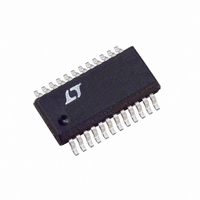LTC4100EG#TRPBF Linear Technology, LTC4100EG#TRPBF Datasheet - Page 23

LTC4100EG#TRPBF
Manufacturer Part Number
LTC4100EG#TRPBF
Description
IC SMART BATTERY CHARGER 24-SSOP
Manufacturer
Linear Technology
Datasheet
1.LTC4100EGPBF.pdf
(30 pages)
Specifications of LTC4100EG#TRPBF
Function
Charge Management
Battery Type
Smart Batteries
Voltage - Supply
6 V ~ 28 V
Operating Temperature
-40°C ~ 85°C
Mounting Type
Surface Mount
Package / Case
24-SSOP (0.200", 5.30mm Width)
Lead Free Status / RoHS Status
Lead free / RoHS Compliant
Available stocks
Company
Part Number
Manufacturer
Quantity
Price
APPLICATIONS INFORMATION
The MOSFET power dissipations at maximum output
current are given by:
where δΔT is the temperature dependency of R
k is a constant inversely related to the gate drive current.
Both MOSFETs have I
includes an additional term for transition losses, which
are highest at high input voltages. For V
current effi ciency generally improves with larger MOSFETs,
while for V
the point that the use of a higher R
C
MOSFET losses are greatest at high input voltage or during
a short circuit when the duty cycle in this switch in nearly
100%. The term (1 + δΔT) is generally given for a MOSFET
in the form of a normalized R
but δ = 0.005/°C can be used as an approximation for low
voltage MOSFETs. C
in the MOSFET characteristics. The constant k = 2 can be
used to estimate the contributions of the two terms in the
main switch dissipation equation.
If the charger is to operate in low dropout mode or with
a high duty cycle greater than 85%, then the topside
P-channel effi ciency generally improves with a larger
MOSFET. Using asymmetrical MOSFETs may achieve cost
savings or effi ciency gains.
The Schottky diode D1, shown in the typical application
on the back page, conducts during the dead-time between
the conduction of the two power MOSFETs. This prevents
the body diode of the bottom MOSFET from turning on and
storing charge during the dead-time, which could cost as
much as 1% in effi ciency. A 1A Schottky is generally a good
size for 4A regulators due to the relatively small average
current. Larger diodes can result in additional transition
losses due to their larger junction capacitance.
The diode may be omitted if the effi ciency loss can be
tolerated.
RSS
PMAIN = V
PSYNC = (V
actually provides higher effi ciency. The synchronous
IN
> 20V the transition losses rapidly increase to
+ k(V
OUT
IN
– V
/V
IN
IN
)
RSS
2
OUT
2
(I
(I
R losses while the PMAIN equation
MAX
MAX
)/V
= Q
)
)(C
IN
2
GD
DS(ON)
(1 + δΔT)R
(I
RSS
/ΔV
MAX
DS(ON)
)(f
DS
)
vs temperature curve,
2
OSC
(1 + δΔT)R
is usually specifi ed
device with lower
IN
)
DS(ON)
< 20V the high
DS(ON)
DS(ON)
and
Calculating IC Power Dissipation
The power dissipation of the LTC4100 is dependent upon
the gate charge of the top and bottom MOSFETs (Q2 &
Q3 respectively) The gate charge (QG) is determined from
the manufacturer’s data sheet and is dependent upon both
the gate voltage swing and the drain voltage swing of the
MOSFET. Use 6V for the gate voltage swing and V
the drain voltage swing.
Calculating V
The LTC4100 V
a. I
b. I
c. I
I
a) I
DD
PD = V
Example: V
PD = 428mW
the IC.
RUN
THRM
ACCEL
= I
Once the LTC4100 determines that there is activity on
the SMBus, it turns on its internal HF oscillator. This
HF oscillator remains on until a stop event occurs or
SDA and SCL are at logic level 1 for the SMBus timeout
period. Then it shuts off the HF oscillator. Thus, the
length of the transmission and the rate of transmission
bursts are more important in determining how much
current the LTC4100 burns, rather than the SCL rate.
In the equation below, I
consumes as a function of the V
active. Since it is hard to quantify the actual messages
going down the SMBus, one must estimate the SMBus
activity level in term of bus utilization per second.
I
where I
RUN
RUN
RUN
= Current due to active clocking and bias inside
current is basically independent of SCL clock rate.
= Message Duty Cycle • 950μA
= Current due to thermistor circuit activity.
= Current due to SMBus acceleration activity.
DCIN
+ I
+ (1 – Message Duty Cycle) • I
Q
QG
I
(typical) = V
THRM
DD
DD
• (f
DCIN
DD
Q3
= 1mA.
Current
OSC
current, or I
= 15nC, I
= 19V, f
+ I
(QG
ACCEL
DD
Q2
OSC
Q
/47.2k
DCIN
+ QG
is the static current the IC
DD
= 345kHz, QG
, consist of three parts:
= 5mA, V
Q3
) + I
DD
LTC4100
voltage when not
DCIN
Q
DD
) + V
Q2
= 5.5V,
= 25nC,
DD
DCIN
23
• I
4100fb
for
DD














